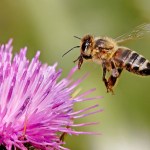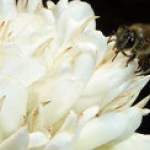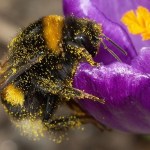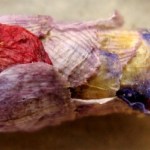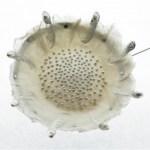flower
Image of honeybee By Fir0002 (Own work) [GFDL 1.2 (http://www.gnu.org/licenses/old-licenses/fdl-1.2.html)], via Wikimedia Commons
A new study conducted by researchers at the University of Guelph found that the use of certain pesticides impacts wildflower pollination by bees. According to a quote by study author Nigel Raine, published in CBCNews, the use of neonicotinoid-type pesticides "modify the way in which information flows through the nervous system."
The research team found that bees gather pollen more frequently, but less efficiently, when exposed to the pesticide compared to…
Honeybee visiting a coffee flower, photo from Geraldine Wright
Apparently humans and honeybees share something in common when it comes to caffeine. Dr. Geraldine Wright (Newcastle University, England) discovered that bees are more likely to return to flowers that produce nectar containing caffeine. Their data suggest caffeine improves memory in bees. Caffeine is present in higher concentrations in the leaves and other tissues of the plant where it provides the added benefit of warding off predators.
According to a quote from The New York Times by Dr. Robert a Raguso at…
Image from: Wikipedia, P7r7
New research from Dr. Daniel Robert and colleagues at the University of Bristol shows that bees are not only attracted to the bright colors and smells of flowers, they can also sense their electrical field.
It has been known that bees develop positive charges as they bump into small charged molecules during flight, resulting in a loss of electrons from their surface. In contrast, flowers accumulate negative charges on their petals as they lose positive charges to the surrounding air. The interaction between a positively charged bee and a negatively charged…
About once a decade (no, I lie - the last was in 2005), our cactus flowers. Here it is again, only this time it has excelled itself and produced four (yes I know you can only see two in this pic). I also rather like the way you can see the flower structure merging into the leaf. There are more pix if you like.
This is also a sentimental cactus: my grandparents used to own it, and more: it was a gift to them from my uncle Roland.
NPR reports on the discovery of a bee that builds tiny, multi-coloured nests out of flower petals. The rare solitary bee Osmia avoseta creates the cocoons out of a mixture of mud, flower petals and nectar. Each case holds a single egg.
The discovery by a group of scientists in Turkey co-incided with that of another team in Iran; the two groups published their findings together in the American Museum Novitae. More pictures and info on NPR.org.
The partnerships between flowering plants and the animals that pollinate them are some of the most familiar in the natural world. The active nature of animals typically casts the plants as the passive partners in this alliance, but in reality, they're just as involved. That becomes particularly apparent when the animals renege on their partnership.
Nicotinia attenuata, a type of wild US tobacco, is usually pollinated by hawkmoths. To lure them in, it opens its flowers at night and releases alluring chemicals. But pollinating hawkmoths often lay their eggs on the plants they visit and the…
tags: new species, biology, botany, orchid, tiniest orchid, Orchidaceae, Platystele, Lou Jost
A close-up of the world's smallest orchid, at just over 2mm from petal tip to petal tip.
Image: Lou Jost.
The world's smallest orchid was discovered recently in a mountainous nature reserve in Ecuador by American botanist Lou Jost. Dr. Jost, a former physicist, now works as a mathematical ecologist, plant biogeographer and conservation scientist, and is one of the world's most expert orchid hunters. In the previous decade, Dr. Jost discovered 60 new species of orchids and 10 other new plant…
Many living things, from chameleons to fish to squid, have the ability to change their colour. But flowers? Yes, over 450 species of flower have the ability to shapeshift, altering their colour and positions over the course of a day. The goal, as with many aspects of a flower's nature, is communication. The secondary palette tells pollinators that a particular flower has already been visited and not only needs no pollen but has little nectar to offer as a reward. The visitor's attentions (and the pollen it carries) are directed towards needier flowers.
The legume Desmodium setigerum is one…
Long pin (detail)
Hand-made paper with cast silver seed inclusions and fine silver.
Sabrina Meyns
Irish artist Sabrina Meyns makes jewelry out of paper and silver. This piece may be less durable than your typical jewelry, but it's certainly more robust than the fragile poppies it mimics, and the translucency and delicacy is breathtaking. Unfortunately, her site only has a few examples of her work, but hopefully we'll see more of her in the future.
Via Daily Art Muse
We have brought you the outstanding time lapse photography of Mochimochi Land in the past, but these new works are breathtaking.
No-holds-barred snail on slug rumpus!
"The Great Foot Race!"
Friends below the fold
Reversible chicken and egg. If only life were so easy.
"Beware the Ninjabun...He's covert, sneaky, and hungry!"
"The world's fattest butterfly thinks it might be time for a diet. The flowers agree."
